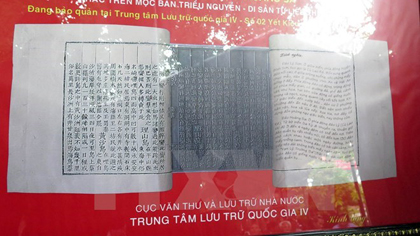Master plan on preserving Nguyen Dynasty wood blocks approved
The Prime Minister has approved a project on preserving and improving value of Nguyen Dynasty wood blocks (moc ban), a UNESCO-recognised documentary heritage item.
 |
| Nguyen Dynasty's wood blocks (Photo: VNA) |
The project aims to improve the public’s knowledge about the blocks’ contents and value. In addition, the project will also raise awareness about the role and value of archives.
The Nguyen Dynasty’s wood blocks are part of a collection of nearly 35,000 wood blocks dating from 1697 to 1945. They were used to print literary and historical documents. If the entire collection were printed, they would fill 152 books about history, geography, literature, legislation and education, according to the document submitted to UNESCO.
In its first phase (2016-2020), the project will focus on producing publications to introduce the Nguyen Dynasty’s wood blocks, building a website on the document and training those working on the project.
Restoration of broken wood blocks, upgrades of management software, documentary filming, conferences and wood block lessons at school will be included in the second phase from 2021-2025.
Apart from their historical value, the wood blocks are important in terms of the artistic skill used to create them. They mark the development of the wood block carving and printing profession in Vietnam.
The blocks were made out of a plate of either thi tree wood, which is yellow and soft, or nha dong, which is smooth and has an ivory colour. These wood varieties were especially good at preserving the shape of the carvings. The carvings were done in reverse so they would appear correctly when printed.
The blocks represent an important part of the country’s feudal history. Under the Nguyen Dynasty, they were used to print information about social standards, articles on the lives and careers of the aristocracy, and historical events. They are original records from the time, making them very valuable.
(Source: VNA)
 về đầu trang
về đầu trang







